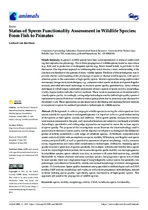| dc.description.abstract | (1) Background: in order to propagate wildlife species (covering the whole spectrum from species suitable for aquaculture to endangered species), it is important to have a good understanding of the quality of their sperm, oocytes and embryos. While sperm quality analyses have mainly used manual assessment in the past, such manual estimations are subjective and largely unreliable. Accordingly, quantitative and cutting‐edge approaches are required to assess the various aspects of sperm quality. The purpose of this investigation was to illustrate the latest technology used in quantitative evaluation of sperm quality and the required cut‐off points to distinguish the differential grades of fertility potential in a wide range of vertebrate species. (2) Methods: computer‐aided sperm analysis (CASA) with an emphasis on sperm motility, 3D tracking and flagellar and sperm tracking analysis (FAST), as well as quantitative assessment of sperm morphology, vitality, acro-some status, fragmentation and many other complimentary technologies. (3) Results: Assessing sperm quality revealed a great deal of species specificity. For example, in freshwater fish like trout, sperm swam in a typical tight helical pattern, but in seawater species sperm motility was more progressive. In amphibian species, sperm velocity was slow, in contrast with some bird species (e.g., ostrich). Meanwhile, in African elephant and some antelope species, fast progressive sperm was evident. In most species, there was a high percentage of morphologically normal sperm, but gener-ally, low percentages were observed for motility, vitality and normal morphology evident in mo-nogamous species. (4) Conclusions: Sperm quality assessment using quantitative methodologies such as CASA motility, FAST analysis, morphology and vitality, as well as more progressive meth-odologies, assisted in better defining sperm quality—specifically, sperm functionality of high‐qual-ity sperm. This approach will assist in the propagation of wildlife species. © 2021 by the author. Licensee MDPI, Basel, Switzerland. | en_US |

